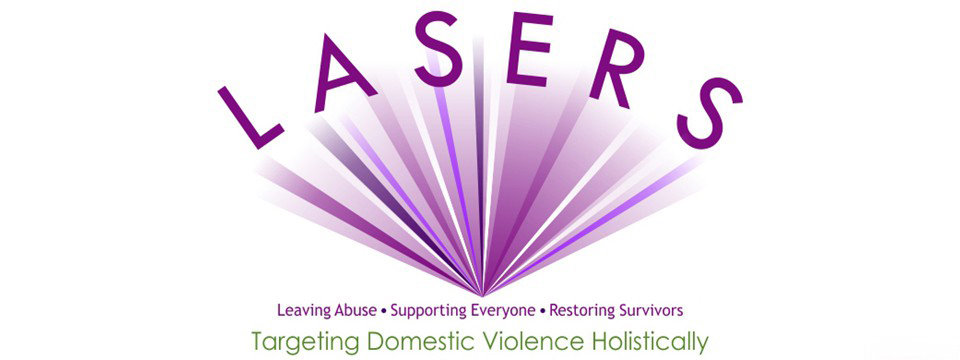 LASERS offers training courses for advocates, schools, organizations, and law enforcement. Click here for information.
LASERS offers training courses for advocates, schools, organizations, and law enforcement. Click here for information.
Resources
What is Domestic Violence? Domestic violence is a term used to describe abusive and/or coercive behaviors or a series of those behaviors among domestic relationships. Domestic relationships are those between spouses, dating partners, cohabitants, family and friends. Domestic violence is a broader term used for family violence, dating violence, intimate partner violence and spousal abuse depending on the nature of the abuse and individuals affected.
Although women are the most commonly reported victims, men and children are affected and can also be victims of any domestic abuse. The person who commits domestic violence is called an abuser or batterer. The number one goal of an abuser is to have control over their victim.
Warning Signs Abusers use many forms of violence in order to control their victims. Physical aggression such as beating, punching, kicking, scratching and biting is the most commonly recognized form of domestic violence. Sexual abuse or sexual assault is another form. There are also more subtle types of abusive behavior such as psychological, emotional, mental, verbal, isolation and financial that abusers use before physical abuse ever occurs. So in order to better recognize domestic violence we have to know the warning signs.
|
Some of the warning signs that you may be in a relationship with abuse:
|
|
Safety Planning If you or a loved one is in a relationship with abuse or perhaps has just left one, you or that person may feel scared or even alone. Know that you are not alone and there is help. It is also important that you are safe and stay safe. Statistics show that most relationships with abuse become fatal for victims after they leave their abusers. Why? Because abusers have lost the one thing they desire to control and are often unable to cope with the feeling of rejection. In the abuser's mind, they feel they are actually losing control. Therefore, having a safety plan is critical when leaving the relationship.
A safety plan are steps you take to protect yourself and children from being further harmed by an abuser. Abusers look for many ways to get back with or get back at their victims. Sometimes they use charm, promises of being better, lies, manipulation, intimidation or plain force to resume the relationship.
You can connect with us or the resources listed on this page so you can be directed to a domestic violence advocate, someone who understands what you are going through, and to create a personalized safety plan. Meanwhile, here are some things you can do to be safe:
In an abusive relationship:*
- Plan how you could get out of the house quickly if your partner becomes violent. Try to position yourself near a door where you can escape quickly.
- Put together a suitcase and keep it at a friend or family member’s house. Put in it clothes for you and the children, needed medicines, important papers, car keys, photographs, money, and emergency phone numbers. Add anything else you might need if you have to leave suddenly.
- Tell neighbors about the abuse and have them call the police if they hear noises coming from your house.
- Talk to your children about how they can keep themselves safe as well.
If you are thinking about leaving a battering relationship:*
- Identify things that have worked in the past to keep you safe.
- Think about what has happened in the past and how the abuser has acted. Identify clues that indicate when things might become violent (i.e. behavioral -- body language, drug/alcohol use, etc. -- and event driven -- paydays, holidays, etc.).
- Identify what you will do if the violence starts again. Can you call the police? Is there a phone in the house? Can you work out a signal with the children or neighbors to call the police or get help?
- Explore ways to have dangerous weapons (i.e. guns, hunting knives, etc.) removed from the house.
- Plan an escape route and practice it. Know where you can go and who you can call for help. Keep a list of addresses and phone numbers where you can go in crisis and keep them in a safe place.
- If possible, open a bank account or hide money to establish or increase independence (more financial tips).
- Gather together the following items and hide them with a trusted individual or somewhere accessible outside the home:
-
- Money/cab fare
- Check book
- Credit card/ATM card
- Order of Protection
- Passport
- Immigration documents
- Work permit
- Public Assistance ID
- Driver's license and registration
- Social Security card
- Your partner's Social Security number
- Medical records
- Insurance policies
- Police records
- Record of violence
- Children's school and immunization records
- Lease
- Birth certificates
- Baby's things (diapers, formula, medication)
- Medications
- Clothing
- Eye glasses
- Family pictures
- Address book
- Important telephone numbers
- Mobile phone/coins to use a pay phone
- Change the locks on doors and windows (if the abuser has a key or access to a key).
- Increase the police's ability to find your house by having a large visible street address outside the house.
- Obtain a P.O. Box and forward all your mail to it.
- Ensure that utility companies will not give out your information to your abuser (more information about confidentiality for victims of domestic violence).
- Determine the safest way to communicate with the abuser if they must have contact. If you agree to meet, always do it in a public place (preferably a place with a security guard or police officer), and it's best to bring someone else. Make sure you are not followed home.
- If your partner follows you in the car, drive to a hospital or fire station and keep honking the horn.
- Create a safety plan for leaving work. Talk with your supervisor and building security at work and provide a picture of the abuser, if possible. If you have an Order of Protection, give the security guard or receptionist a copy.
- Teach your children a safety plan, including calling the police or family and friends if they are taken and where to go during an emergency.
- Talk to your schools and childcare provider about who has permission to pick up the children and develop other special provisions to protect the children.
- Keep a journal of harassing phone calls and times you may see your abuser around the work place or neighborhood. Save and/or print any threatening emails. Keep a journal of anything that happens between you, the abuser, and the children regarding visitation.
*Resource: The National Network to End Domestic Violence www.nnedv.org/resources/stats/gethelp/ifyouarebeingabused.html
Some Statistics**
- Every year, 1 in 3 women who is a victim of homicide is murdered by her current or former partner.
- Approximately 1.3 million women and 835,000 men are physically assaulted by an intimate partner annually in the United States.
- Every year, more than 3 million children witness domestic violence in their homes.
- Children who live in homes where there is domestic violence also suffer abuse or neglect at high rates (30% to 60%).
- Nearly 1.5 million high school students nationwide experience physical abuse from a dating partner in a single year.
- Domestic violence victims lose nearly 8 million days of paid work per year in the US alone—the equivalent of 32,000 full-time jobs.
- Domestic violence contributes to poor health for many survivors. For example, chronic conditions like heart disease or gastrointestinal disorders can become more serious due to domestic violence.
Who to Contact
There are organizations you can call for help, to receive more information or just to talk with someone. You are never alone and help is available.
| National Hotlines | The National Domestic Violence Hotline 1.800.799.7233 |
| The National Teen Dating Abuse Hotline 1.866.331.9474 or text "loveis" to 22522 | |
| State and Legislative Resources | National Coalition Against Domestic Violence |
| US State & Territorial Coalitions - Listing | |
| Women's Law | |
|
International | The Hot Peach Pages |
| Brochures |           |
| Facts Everyone Should Know About Intimate Partner Violence, Sexual Assault, and Stalking | Download full resolution image of infographic [.JPG 4.3 MB] Download PDF version of infographic |

**Resources:
www.americanbar.org/groups/domestic_violence/resources/statistics.html
www.loveisrespect.org/is-this-abuse/dating-violence-statistics

